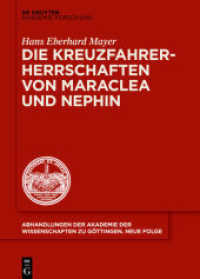- ホーム
- > 洋書
- > 英文書
- > Science / Mathematics
Full Description
Pearson Physics, Global Edition offers a "concepts first" approach to physics, supported by a superior, step-by-step problem-solving process. The text illustrates how physics applies to everything in our world and how theoretical concepts can be connected to everyday experiences. Comprehensive yet easy-to-follow discussions break down complex topics into understandable nuggets of knowledge and bolster students' understanding of core topics and overarching principles in physics. Thorough assessments at the end of each chapter allow students to evaluate their progress and reinforce essential skills.
Contents
1. Introduction to Physics
1.1 Physics and the Scientific Method
1.2 Physics and Society
1.3 Units and Dimensions
1.4 Basic Math for Physics
1.5 Problem Solving in Physics
2. Introduction to Motion
2.1 Describing Motion
2.2 Speed and Velocity
2.3 Position-Time Graphs
2.4 Equation of Motion
3. Acceleration and Accelerated Motion
3.1 Acceleration
3.2 Motion with Constant Acceleration
3.3 Position-Time Graphs for Constant Acceleration
3.4 Free Fall
4. Motion in Two Dimensions
4.1 Vectors in Physics
4.2 Adding and Subtracting Vectors
4.3 Relative Motion
4.4 Projectile Motion
5. Newton's Laws of Motion
5.1 Newton's Laws of Motion
5.2 Applying Newton's Laws
5.3 Friction
6. Work and Energy
6.1 Work
6.2 Work and Energy
6.3 Conservation of Energy
6.4 Power
7. Linear Momentum and Collisions
7.1 Momentum
7.2 Impulse
7.3 Conservation of Momentum
7.4 Collisions
8. Rotational Motion and Equilibrium
8.1 Describing Angular Motion
8.2 Rolling Motion and the Moment of Inertia
8.3 Torque
8.4 Static Equilibrium
9. Gravity and Circular Motion
9.1 Newton's Law of Universal Gravity
9.2 Applications of Gravity
9.3 Circular Motion
9.3 Planetary Motion and Orbits
10. Temperature and Heat
10.1 Temperature, Energy, and Heat
10.2 Thermal Expansion and Energy Transfer
10.3 Heat Capacity
10.4 Phase Changes and Latent Heat
11. Thermodynamics
11.1 The First Law of Thermodynamics
11.2 Thermal Processes
11.3 The Second and Third Laws of Thermodynamics
12. Gases, Liquids, and Solids
12.1 Gases
12.2 Fluids at Rest
12.3 Fluids in Motion
12.4 Solids
13. Oscillations and Waves
13.1 Oscillations and Periodic Motion
13.2 The Pendulum
13.3 Waves and Wave Properties
13.4 Interacting Waves
14. Sound
14.1 Sound Waves and Beats
14.2 Standing Sound Waves
14.3 The Doppler Effect
14.4 Human Perception of Sound
15. The Properties of Light
15.1 The Nature of Light
15.2 Color and the Electromagnetic Spectrum
15.3 Polarization and Scattering of Light
16. Reflection and Mirrors
16.1 The Reflection of Light
16.2 Plane Mirrors
16.3 Curved Mirrors
17. Refraction and Lenses
17.1 Refraction
17.2 Applications of Refraction
17.3 Lenses
17.4 Applications of Lenses
18. Interference and Diffraction
18.5 Interference
18.6 Interference in Thin Films
18.7 Diffraction
18.8 Diffraction Gratings
19. Electric Charges and Forces
19.1 Electric Charge
19.2 Electric Force
19.3 Combining Electric Forces
20. Electric Fields and Electric Energy
20.1 The Electric Field
20.2 Electric Potential Energy and Electric Potential
20.3 Capacitance and Energy Storage
21. Electric Current and Electric Circuits
21.1 Electric Current, Resistance, and Semiconductors
21.2 Electric Circuits
21.3 Power and Energy in Electric Circuits
22. Magnetism and Magnetic Fields
22.1 Magnets and Magnetic Fields
22.2 Magnetism and Electric Currents
22.3 The Magnetic Force
23. Electromagnetic Induction
23.1 Electricity from Magnetism
23.2 Electric Generators and Motors
23.3 AC Circuits and Transformers
24. Quantum Physics
24.1 Quantized Energy and Photons
24.2 Wave-Particle Duality
24.3 The Heisenberg Uncertainty Principle
25. Atomic Physics
25.1 Early Models of the Atom
25.2 Bohr's Model of the Hydrogen Atom
25.3 The Quantum Physics of Atoms
26. Nuclear Physics
26.1 The Nucleus
26.2 Radioactivity
26.3 Applications of Nuclear Physics
26.4 Fundamental Forces and Elementary Particles
27. Relativity
27.1 The Postulates of Relativity
27.2 The Relativity of Time and Length
27.3 E = mc^2
27.4 General Relativity
Math Review Appendices
Appendix A: Selected Answers
Appendix B: Additional Problems
Appendix C: Tables
Appendix D: Safety in the Laboratory
Credits
Index








